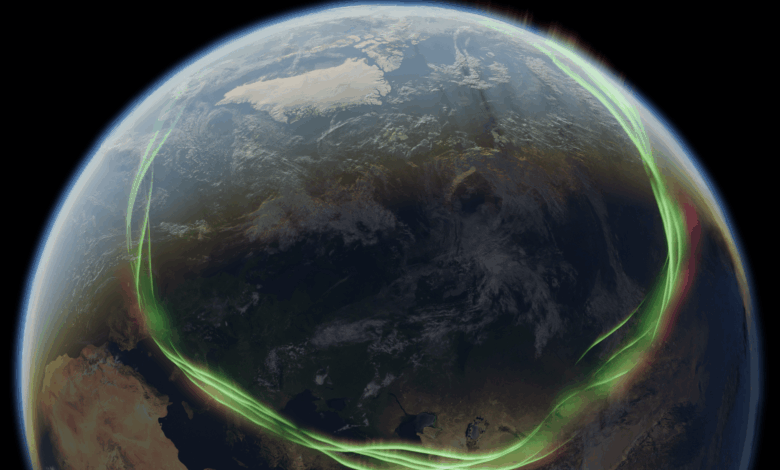Sunscreen may have kept ancient humans alive during a polar reversal

The interaction between ancient humans and the Earth’s magnetic field has been a topic of fascination for scientists for many years. A recent study published in the journal Science Advances sheds light on how ancient Homo sapiens may have adapted to changes in the Earth’s magnetic field, specifically during a period known as the Laschamps excursion, which occurred about 41,000 years ago.
Earth’s magnetic field is generated by the rotation of the planet’s core, which is composed of molten iron. This magnetic field helps protect Earth from cosmic radiation, which can have harmful effects on the planet’s ozone layer and let in more ultraviolet (UV) light. During the Laschamps excursion, the magnetic field weakened, causing auroras to be visible across most of the globe and allowing more harmful UV light to penetrate the Earth’s atmosphere.
Ancient Homo sapiens living around this time may have developed technologies to protect themselves from the increased levels of UV radiation. Evidence suggests that these early humans may have used mineral sunscreen, tailored clothing, and sought shelter in caves to avoid the harmful effects of the sun’s rays.
The study’s authors, including space physicist Agnit Mukhopadhyay from the University of Michigan, used advanced modeling techniques to reconstruct the Earth’s geospace system during the Laschamps excursion. By combining models of the geomagnetic field, space plasma environment, and auroras, the researchers were able to create a 3D map showing where charged particles were able to penetrate the Earth’s magnetic field.
The results of the study suggest that the changes in the Earth’s magnetic field during the Laschamps excursion coincided with periods of change for groups of humans living on the planet. This may have led to the development of technologies like tailored clothing and the use of pigments like ochre, which has sun-protective properties when applied to the skin.
Overall, this study provides valuable insights into how ancient humans may have adapted to changes in the Earth’s magnetic field and highlights the importance of understanding the interactions between humans and their environment throughout history. As we continue to study the Earth’s magnetic field and its impact on human societies, we may uncover even more fascinating connections between ancient civilizations and the natural world. Neanderthals, once prevalent in Europe, vanished as a species around 40,000 years ago. The disappearance of Neanderthals has long been a topic of interest in anthropology, with researchers like Raven Garvey from the University of Michigan delving into the differences between Neanderthals and modern humans to understand this phenomenon.
One major distinction Garvey highlights is the potential role of clothing in the survival of anatomically modern humans compared to Neanderthals. Archaeological evidence shows that modern humans had the technological know-how to create tailored clothing, using tools like scrapers, needles, and awls for hide production and sewing. This tailored clothing provided better insulation, allowing for increased mobility in search of food and protection against sun damage.
Moreover, the use of ochre, a natural pigment with sunscreen-like properties, may have also played a role in the survival of modern humans. Ancient humans utilized ochre for painting objects, cave walls, and even body decoration, potentially as a form of sun protection. The increased production of ochre among anatomically modern humans during the Laschamps excursion hints at its use for this purpose.
Garvey’s research offers a fresh perspective on existing data, suggesting that these factors—clothing technology and the use of ochre—could have contributed to the survival and eventual dominance of anatomically modern humans over Neanderthals. This shift in perspective sheds light on the adaptability and resourcefulness of early humans in the face of changing environmental conditions.
Looking ahead, the study also raises questions about how future environmental changes, such as magnetic field reversals, could impact human survival. By studying prehistoric Earth during events like the Laschamps excursion, researchers gain insights into how life persisted under different atmospheric conditions. This research serves as a reminder of the resilience of early humans and the adaptability required to thrive in ever-changing environments. The world is a vast and diverse place, filled with countless wonders and mysteries waiting to be discovered. From the depths of the ocean to the heights of the mountains, there is no shortage of beauty and intrigue to be found in every corner of the globe.
One of the most fascinating aspects of our world is the incredible diversity of wildlife that inhabits it. From the largest mammals to the tiniest insects, the animal kingdom is a rich tapestry of life forms, each one uniquely adapted to its environment and playing a vital role in the delicate balance of nature.
One of the most iconic animals in the world is the lion, known as the king of the jungle. These majestic creatures are powerful predators, with sharp claws and teeth that make them fearsome hunters. Lions are social animals, living in prides that are led by a dominant male known as the pride leader. The females in the pride do most of the hunting, working together to take down large prey such as zebras and wildebeest.
Another incredible animal is the blue whale, the largest animal to have ever lived on Earth. These massive creatures can grow up to 100 feet long and weigh as much as 200 tons. Blue whales are filter feeders, using baleen plates in their mouths to strain tiny krill from the water. Despite their enormous size, blue whales are surprisingly graceful swimmers, gliding effortlessly through the ocean with their powerful tails.
In the rainforests of South America, you can find the colorful and charismatic poison dart frog. These tiny frogs are known for their bright colors and toxic skin secretions, which they use to defend themselves against predators. Despite their small size, poison dart frogs are highly territorial and will fiercely defend their territory from intruders.
In the frozen landscapes of the Arctic, the polar bear reigns supreme. These massive predators are perfectly adapted to their icy environment, with thick fur and layers of blubber to keep them warm in the frigid temperatures. Polar bears are powerful swimmers and can cover long distances in search of food, primarily hunting seals on the sea ice.
These are just a few examples of the incredible diversity of wildlife that can be found on our planet. Each species has its own unique characteristics and behaviors, making them a fascinating subject of study for scientists and nature enthusiasts alike. As we continue to explore and learn more about the natural world, we are constantly amazed by the wonders that surround us and the incredible creatures that inhabit our planet.




